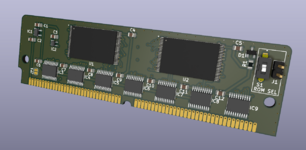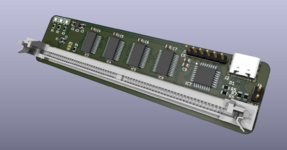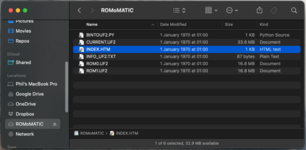pgreenland
Well-known member
Hi All,
Having used BMOW's Rominators in my first two SE/30 restorations, I found them out of stock while looking for a third.....so thought it was time to build my own custom SIMM and programmer.
I also wanted slightly more space than the 2MB available, so took some inspiration from other SIMM designs and made use of low voltage (3.3v) flash chips with buffers between them and the SE/30 (would like to give credit to the original inspiration here but can't find the original source, if you know let me know).
Providing 2 x 8MB switchable images via a local dip switch or remote header.



I've been using the stock SE/30 ROM in the first slot. Along with a ROM created using bbraun's disk driver and modified image: http://synack.net/~bbraun/macromboot.html in the second, stuffed full of all the diagnostics tools I wanted to fit into the BMOW ROM. Without any compression boot times from the ROM disk are possibly slightly faster than the BMOW with its compressed ROM disk image, although I haven't timed them....just a finger in the air sort of measurement.
The programmer itself is somewhat self-contained, it emulates a USB disk drive and makes use of the UF2 file format....developed by Microsoft to program Microcontrollers and used by controllers such as the Raspberry Pi Pico. It makes reading/writing the ROM is a drag and drop operation on any OS.
Connecting it to my Mac yields:

Files ROM0.UF2, ROM1.UF2 and CURRENT.UF2 allow reading the first, second or both ROM images from the connected SIMM respectively in the programmer file format.
BINTOUF2.PY is a python script which allows raw binary ROM images to be converted to the UF2 programming format. Once in this format programming one or both ROM slots is simple case of dragging and dropping into the disk. Or having the python script write directly to the disk.
It's not quite as fast as I was hoping....should have probably calculated the expected read/write times in advance. Reading or writing the complete 16MB programming image takes around 5mins 30s.
Posted to gauge potential interest in taking the project any further than the 4 SIMMS I've so far hand built for my machines.
Thoughts?
Thanks,
Phil
Having used BMOW's Rominators in my first two SE/30 restorations, I found them out of stock while looking for a third.....so thought it was time to build my own custom SIMM and programmer.
I also wanted slightly more space than the 2MB available, so took some inspiration from other SIMM designs and made use of low voltage (3.3v) flash chips with buffers between them and the SE/30 (would like to give credit to the original inspiration here but can't find the original source, if you know let me know).
Providing 2 x 8MB switchable images via a local dip switch or remote header.



I've been using the stock SE/30 ROM in the first slot. Along with a ROM created using bbraun's disk driver and modified image: http://synack.net/~bbraun/macromboot.html in the second, stuffed full of all the diagnostics tools I wanted to fit into the BMOW ROM. Without any compression boot times from the ROM disk are possibly slightly faster than the BMOW with its compressed ROM disk image, although I haven't timed them....just a finger in the air sort of measurement.
The programmer itself is somewhat self-contained, it emulates a USB disk drive and makes use of the UF2 file format....developed by Microsoft to program Microcontrollers and used by controllers such as the Raspberry Pi Pico. It makes reading/writing the ROM is a drag and drop operation on any OS.
Connecting it to my Mac yields:

Files ROM0.UF2, ROM1.UF2 and CURRENT.UF2 allow reading the first, second or both ROM images from the connected SIMM respectively in the programmer file format.
BINTOUF2.PY is a python script which allows raw binary ROM images to be converted to the UF2 programming format. Once in this format programming one or both ROM slots is simple case of dragging and dropping into the disk. Or having the python script write directly to the disk.
It's not quite as fast as I was hoping....should have probably calculated the expected read/write times in advance. Reading or writing the complete 16MB programming image takes around 5mins 30s.
Posted to gauge potential interest in taking the project any further than the 4 SIMMS I've so far hand built for my machines.
Thoughts?
Thanks,
Phil
